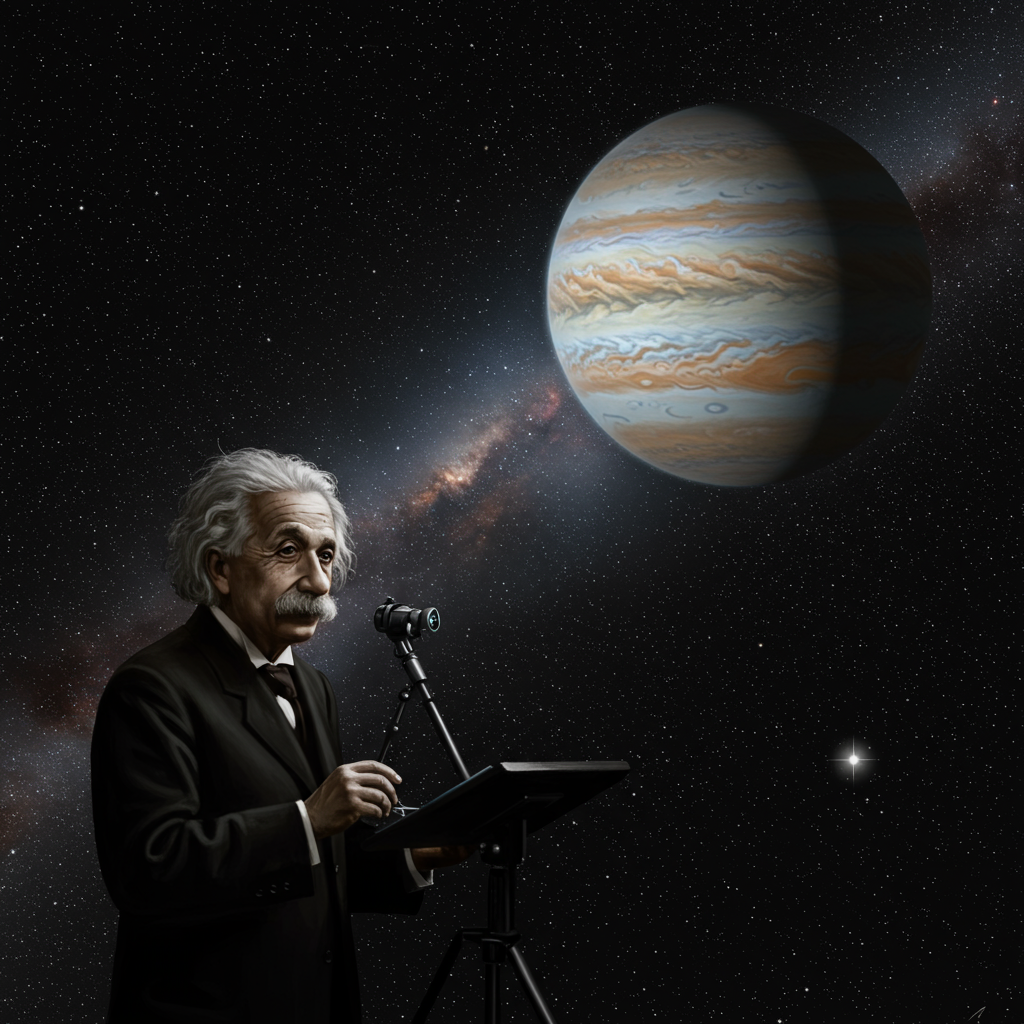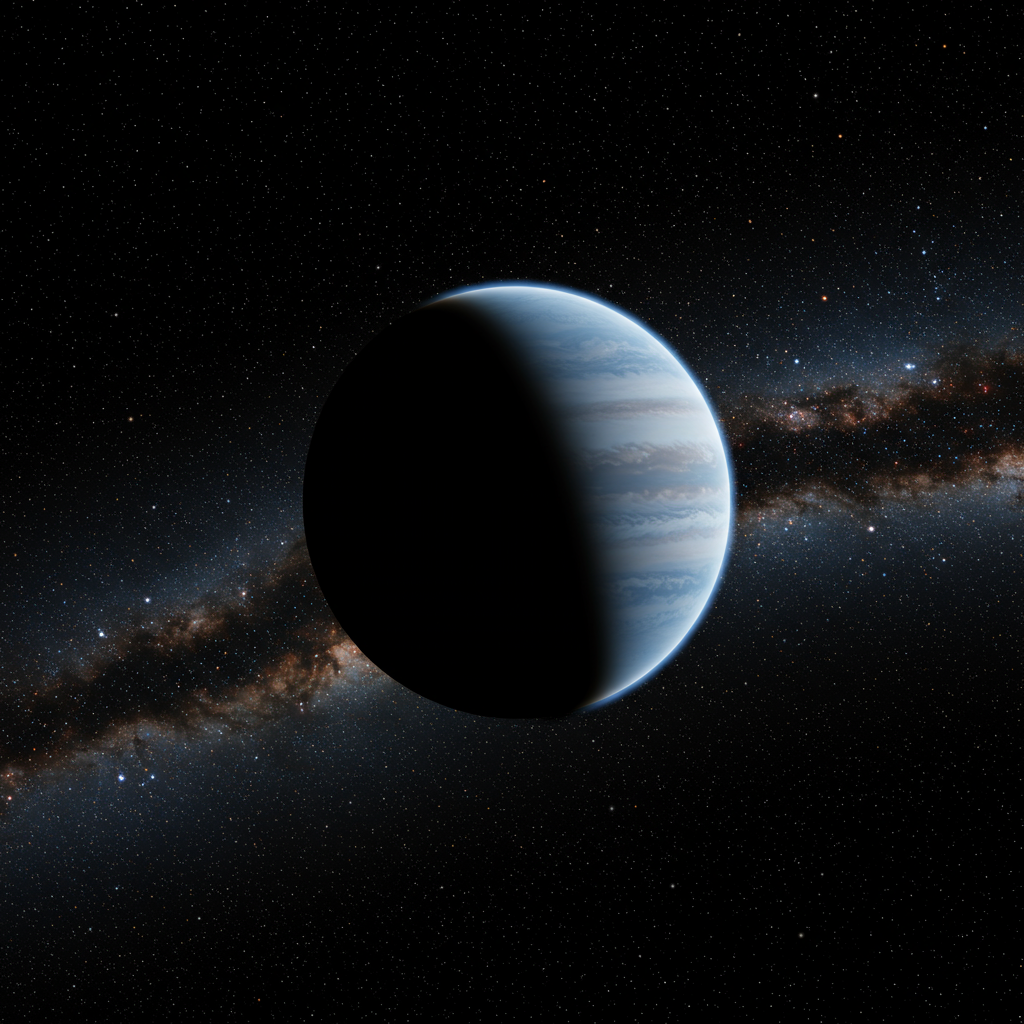A groundbreaking discovery at the very fringes of our home galaxy is reshaping how we understand planet formation. Astronomers have pinpointed a massive, rare planet situated deep within the Milky Way’s expansive outskirts. This alien world, a gas giant comparable in size to Jupiter, is only the third planet ever identified so far from our galaxy’s dense central hub. Finding it required leveraging a cosmic phenomenon first predicted by Albert Einstein over a century ago: the warping of space-time by gravity.
A Galactic Discovery on the Fringes
The newly found exoplanet, officially designated AT2021uey b, resides approximately 3,200 light-years from Earth. This places it significantly distant from the bustling, star-rich regions closer to the galactic center. Orbiting a small, cool M dwarf star, this gas giant completes a single orbit roughly every 4,170 days. Its location is particularly noteworthy because regions far from the galactic core are typically sparse in the heavier elements thought essential for building planets, especially massive ones like AT2021uey b. The existence of such a large planet here challenges current models of how and where planets can form in the universe.
Einstein’s Cosmic Lens: How Microlensing Works
The method used to detect AT2021uey b is as remarkable as the planet’s location. Scientists utilized gravitational microlensing, an effect rooted in Albert Einstein’s revolutionary theory of general relativity. This theory fundamentally changed our understanding of gravity. Einstein proposed that gravity isn’t a mysterious force pulling objects together; instead, it’s a consequence of mass and energy warping the very fabric of the universe, known as space-time.
The Microlensing Phenomenon Explained
When a massive object, such as a star or a planet, passes directly in front of a more distant light source from our perspective, its gravity bends the light from the background object. This bending acts like a natural cosmic lens. Instead of seeing a single point of light, the background source appears magnified. If the alignment is precise, the light can be amplified dramatically, causing a temporary, noticeable spike in the source’s brightness. This fleeting magnification is the ‘microlensing’ signal astronomers look for.
Beyond Transits and Wobbles
This technique differs significantly from the most common methods for finding exoplanets. Transit photometry detects planets when they pass in front of their host star, causing a slight dip in the star’s brightness. The radial velocity method identifies planets by observing the tiny wobble they cause in their star’s motion due to gravitational tugs. Microlensing, however, doesn’t rely on the host star’s direct light or motion relative to Earth. Instead, it detects the gravitational ‘shadow’ or lensing effect of the planet itself, even if the planet and its host star are faint or very far away. This makes it uniquely powerful for finding distant or free-floating planets that other methods might miss.
Pinpointing the Distant World
The first hint of AT2021uey b’s presence came in 2021. Data from the European Space Agency’s Gaia space telescope, which precisely maps stars in our galaxy, captured a momentary spike in the brightness of a distant star. This spike was characteristic of a microlensing event. Observing such an event requires immense expertise, patience, and a degree of luck, as study co-author Marius Maskoliūnas pointed out. Precise alignment of the background star and the lensing object is crucial, and distinguishing true microlensing from other stellar variations requires sifting through vast amounts of data.
Following the initial Gaia detection, astronomers conducted detailed observations from the Molėtai Astronomical Observatory in Vilnius, Lithuania. These follow-up measurements allowed them to analyze the specific pattern of the brightness change caused by the lensing. By carefully studying this light curve, they could deduce the properties of the object causing the lens effect. Their analysis revealed the source was a planet with a mass about 1.3 times that of Jupiter. They also determined the host star is approximately half the temperature of our Sun and the planet orbits it at a distance four times greater than Earth orbits the Sun.
Challenging Planet Formation Theories
The discovery of a massive gas giant like AT2021uey b so far out from the Milky Way’s central bulge is particularly intriguing for planetary science. The galactic outskirts are believed to be less abundant in the heavier elements – sometimes called “metals” by astronomers – needed to form planets, especially large, rocky cores thought to be necessary for gas giant formation in some models. The presence of a substantial planet in such a metal-poor environment suggests that planets might form or migrate to distant regions more readily than previously thought. As astronomer Edita Stonkutė commented, such discoveries, much like the initial surprise of finding “hot Jupiters” close to their stars, force scientists to continually revise and update our models of planetary formation based on observational evidence.
Gravitational Lensing: More Than Just Planet Hunting
The microlensing technique used to find AT2021uey b is a specific application of the broader phenomenon of gravitational lensing, which leverages space-time warping for astronomical study. Massive objects bending light act as cosmic magnifying glasses, a concept fully described by Einstein’s general relativity. Another striking example is the “Einstein Ring.” This occurs when a distant light source is almost perfectly aligned behind a massive foreground galaxy or cluster. The light is bent into a distorted ring shape around the foreground object.
Recent discoveries, like the closest-ever Einstein Ring found by the ESA’s Euclid telescope, further highlight the power of gravitational lensing. These rings, though predicted by Einstein in 1936, were thought perhaps impossible to observe with early technology. Modern telescopes confirm their existence and utility. Studying these warped images allows astronomers to investigate the mass distribution of the lensing object, including the elusive dark matter, which doesn’t emit light but exerts gravity. They can also learn about the properties of the extremely distant, lensed galaxies, acting as natural cosmic telescopes. The ability to study mass via light bending provides a critical way to test Einstein’s theory of gravity itself by comparing lensing mass measurements with other methods like observing star motions.
The Future of Finding Faraway Worlds
The successful use of microlensing to find a rare planet like AT2021uey b underscores its importance for exploring regions of space inaccessible to other methods. While requiring precise alignments and careful data analysis, this technique holds promise for uncovering more hidden worlds, including free-floating planets not bound to any star, or those residing far in the galactic periphery. As missions like Gaia continue to map the sky and future telescopes offer improved observational capabilities, astronomers may find more surprises, further expanding our understanding of where and how planets populate our galaxy.
Frequently Asked Questions
What is gravitational microlensing and how did it help find this planet?
Gravitational microlensing is a phenomenon where a massive object, like a planet, passing in front of a distant star briefly bends and magnifies the star’s light. This effect is a consequence of Einstein’s theory that gravity warps space-time. By detecting and analyzing this temporary spike in brightness, astronomers can infer the presence and properties of the hidden lensing object, which, in this case, was the planet AT2021uey b.
How rare is it to find a planet like AT2021uey b?
Finding AT2021uey b is exceptionally rare due to its location. It is only the third planet ever discovered so far out at the edge of the Milky Way’s central bulge. This region is less dense and thought to be less rich in the heavier elements needed for planet formation compared to the galactic center. Discovering a massive gas giant here challenges existing theories about where large planets can form or exist.
Does finding this planet support or challenge Einstein’s theory of relativity?
The discovery method relies entirely on a phenomenon – gravitational lensing – predicted by Albert Einstein’s theory of general relativity. The fact that astronomers successfully used this prediction to find the planet validates Einstein’s understanding of how gravity affects space-time and light. While the planet’s location challenges planet formation models, the detection method directly supports Einstein’s work.
Conclusion
The discovery of AT2021uey b using the powerful lens of gravitational microlensing represents a significant achievement in exoplanet astronomy. Not only has it revealed a rare world residing in an unexpected location at the Milky Way’s edge, but it also serves as a testament to the enduring accuracy and utility of Albert Einstein’s predictions about the cosmos. Findings like this push the boundaries of our knowledge, demonstrating that the universe continues to hold surprises and that sophisticated techniques, rooted in fundamental physics, are essential for uncovering them. As we continue to explore the vastness of space, the insights gained from phenomena like gravitational lensing will be crucial in mapping the hidden populations of planets in our galaxy and beyond.
Word Count Check: 1077



